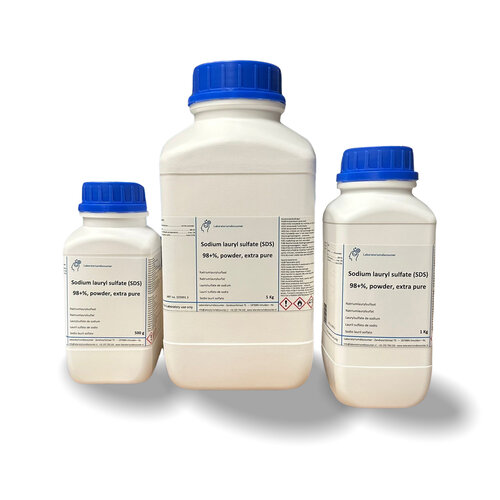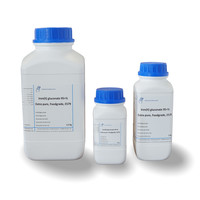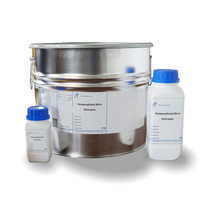You have no items in your shopping cart
Sodium lauryl sulfate (SDS) 98+%, powder, extra pure
- Buy 2 and save 5%
- Buy 6 and save 10%
What is Sodium Lauryl Sulfate?
Sodium Lauryl Sulfate, also known as sodium laureth sulfate or sodium dodecyl sulfate (SLS), is a synthetic detergent and foaming agent commonly used in the production of personal care products and household cleaning products. It is a white powder. The chemical formula for sodium lauryl sulfate (SLS) is C12H25NaO4S
This formula gives the composition of the molecule again, where C stands for carbon, H stands for hydrogen, Na stands for sodium, O stands for oxygen and S stands for sulfur. The "12" in C12 represents the number of carbon atoms in the lauryl part of the molecule, indicating that this is a lauryl sulfate.
What is Sodium Lauryl Sulfate used for?
Sodium lauryl sulfate has various applications in different fields due to its cleaning and foaming properties. Here are some of the top uses by field:
-
Personal care:
- Shampoo and conditioner: SLS is often used as a cleanser and foaming agent in hair care products.
- Toothpaste: It is used to foam toothpaste and to remove dirt and plaque.
- Shower gel and soap: SLS helps remove dirt and oil from the skin and provides lather.
- Shaving cream: It is added to shaving foam to create a rich lather.
-
Pharmaceuticals:
- SLS can be used in some pharmaceutical formulations for oral use as a surfactant to help disperse and dissolve drugs.
-
Household cleaning products:
- SLS is often used in cleaning products such as dish soap, floor cleaners and all-purpose cleaners because of its ability to remove dirt and grease.
-
Industrial applications:
- In industry, SLS is sometimes used as an emulsifying agent or a foaming agent in various processes, such as in the production of polymers and plastics.
-
Textile industry:
- SLS can be used in the textile industry as a wetting agent or a surfactant in certain dyeing and processing processes.
-
Research and development:
- In laboratories, SLS is sometimes used as a reference material or a standard in chemical and physical studies.
It is important to note that while SLS has many uses for its cleansing properties, some people may be sensitive for SLS and may experience skin irritation with prolonged or repeated contact. Therefore, alternative surfactants are available to products that are considered gentler on the skin.
What are the chemical properties of Sodium Lauryl Sulfate?</p >
Sodium lauryl sulfate (SLS) is a surfactant with various chemical properties. Here are some of the key chemical properties of SLS:
-
Hydrophilic and hydrophobic moieties: SLS has a hydrophilic (hydroattracting) sulfate group (-SO4Na) and a hydrophobic (water-repellent) long hydrocarbon chain (lauryl chain with 12 carbon atoms). This dual nature makes SLS effective at emulsifying water and grease, which explains its cleaning ability.
-
Foam Forming: SLS is known for its excellent foam forming characteristics. It can trap air in water to create foam, which is why it is used in products such as shampoo, soap and toothpaste.
-
Solubility: SLS is good soluble in water, which is important for personal care and cleaning product applications, where it helps remove dirt and oil.
-
Surfactant properties: SLS has surfactant properties, meaning it can reduce the surface tension of liquids and bind to both water molecules and oil molecules. This allows it to loosen dirt and grease from surfaces, making them easier to rinse away.
-
Ionic nature: SLS is an ionic compound and consists of positive charged sodium ions (Na+) and negatively charged sulfate ions (-SO4). This makes it an electrolyte, meaning it can dissociate into these ions in water.
-
pH dependence: The surfactant properties of SLS are pH dependent. It is most effective at a neutral or slightly alkaline pH. In acidic conditions it may be less effective.
Is Sodium Lauryl Sulfate dangerous?
Working safely with sodium lauryl sulfate (SLS) is essential to minimize exposure to this chemical ingredient and potential prevent health risks. Here are some guidelines for working safely with SLS:
-
Personal protective equipment (PPE):
- Wear personal protective equipment such as lab coats, gloves and safety glasses when working with SLS. This protective clothing helps prevent direct contact with the skin and eyes.
-
Good ventilation:
- Ensure adequate ventilation in the work area to minimize fumes and vapor formation. If SLS is used in powder form, avoid inhalation of dust particles.
-
Limit exposure:
- Minimize exposure to SLS by limiting the amount of exposed skin and wearing personal protective equipment. Immediately wash all exposed skin if there has been contact with SLS.
-
Emergency procedures:
- Ensure employees are aware of emergency procedures in case of accidents or spills. This may include flushing the skin and eyes with plenty of water.
-
Storage and handling:
- SLS should be stored in tightly closed containers in a cool, dry place, separated from substances that are incompatible. Follow manufacturer's instructions for proper storage and handling.
-
Labeling:
- Ensure that all containers containing SLS are clearly labeled to avoid confusion.
-
Training:
- Ensure personnel working with SLS are adequately trained in proper procedures and safety measures.
-
Environmental considerations:
- Be aware of the environmental impact of SLS and ensure that waste materials are treated and disposed of responsibly in accordance with applicable regulations.
It is critical to follow the specific safety regulations and guidelines of your workplace or laboratory and to contact your safety officer or expert if you have any questions or concerns about working safely with SLS. Safety instructions may vary depending on the application and the level of exposure to SLS.
Buy sodium lauryl sulphate at Laboratoriumdiscounter
Buying sodium lauryl sulfate (SLS) at Laboratoriumdiscounter is wise for the following reasons:
-
Quality and specifications: Laboratory discounter offers high quality products with detailed specifications. This is critical if you need SLS for laboratory testing or other applications where precision and consistency are important.
-
Safety and Compliance: Laboratory Discounter understands the specific safety requirements and regulations that apply to the supply of chemicals to laboratories and research institutions. We are often well informed about storage, labeling and documentation requirements, which contributes to safety and regulatory compliance.
-
Trusted Source :Laboratory discounter has a good reputation in the industry. You can rely on our products and services, and we often have long-term relationships with customers.
-
Technical support: VLaboratoriumdiscounter offers technical support and expertise to help you to help you choose the right product and solve any problems that may arise.
-
Customization: Laboratory discounter can offer customized solutions if you have specific has requirements for SLS in your research or production processes.
-
Price advantage: While many suppliers can sometimes charge higher prices than Laboratory Discounter, we often offer competitive prices for high quality chemicals. In addition, we can offer price discounts for larger quantities.
-
Convenience: Buying from Laboratory Discounter is also time-saving and convenient, because we understand well what laboratories and research institutions need and make these products easily available.
Technical data:
Sodium dodecyl sulphate, SLS, Dodecyl sulphate sodium salt , Lauryl sulphate sodium salt, Sodium lauryl sulphate
Empirical formula C12H25NaO4S
Molar mass (M) 288.38 g/mol
Boiling point (bp) 216 °C
Flash point ( flp) 170 °C
Melting point (mp) 205 °C
ADR 4.1 III
WGK 2
CAS No. 151-21-3
EC No. 205-788-1
UN No. 1325
$$$$$
Hazard statements
H228 Flammable solid
H302+H332 Harmful if swallowed or if inhaled
H315 Causes skin irritation
H318 Causes serious eye damage
H335 May cause respiratory irritation
Precautionary statements
Precautionary statements - prevention
P210 Keep away from heat/sparks/open flames/hot surfaces. - No smoking
P261 Avoid breathing dust/fume/gas/mist/vapours/spray
P280 Wear protective gloves
Precautionary statements - response
P302+P352 IF ON SKIN: Wash with plenty of soap and water
P305+P351+P338 IF IN EYES: Rinse cautiously with water for several minutes. Remove contact lenses, if present and easy to do. Continue rinsing
P370+P378 In case of fire: Use sand, carbon dioxide or powder extinguisher for extinction
Precautionary statements - storage
P403+P233 Store in a well-ventilated place. Keep container tightly closed
Precautionary statements - disposal
P501 Dispose of contents/container to industrial combustion plant








